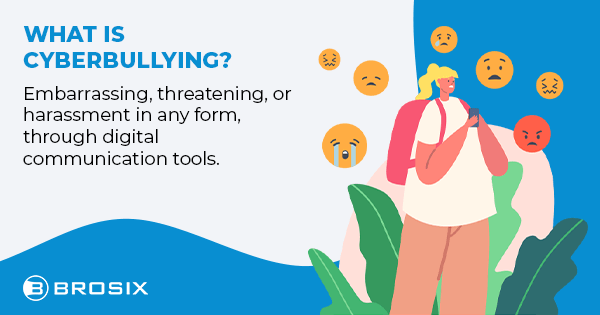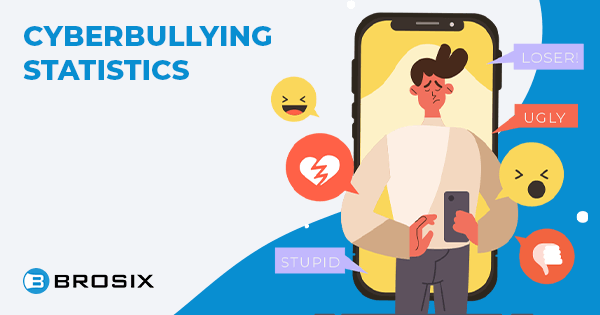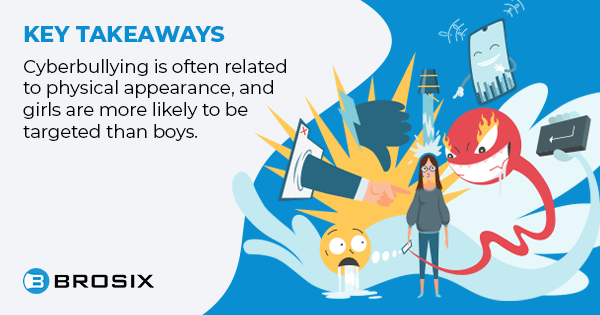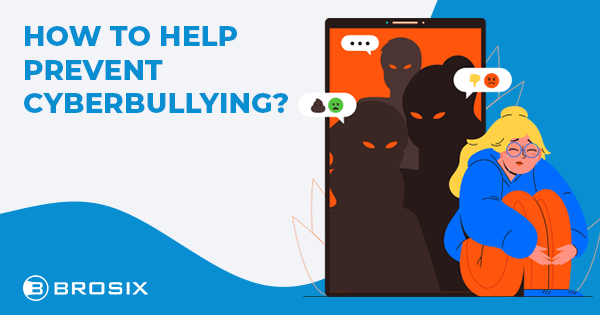The internet was probably the greatest invention of the 20th century, opening so many new doors. Thanks to it, people are able to connect, work, access education programs, and much more with extraordinary ease.
However, the widespread prevalence of social media platforms, especially over recent years, has also brought some serious reason for concern.
With the disappearance of barriers imposed by physical space, people are enjoying a form of freedom that can sometimes have a more negative than positive impact. One of the greatest issues raised by online spaces is the rise of cyberbullying.
Cyberbullying is a serious issue increasing anxiety among children and teenagers nowadays. In an attempt to raise awareness on this matter, we’ve highlighted cyberbullying’s negative effects through a list of 25 cyberbullying statistics.
1. What is cyberbullying?

Cyberbullying is: embarrassing, threatening, or harassment in any form, through digital communication tools. Regardless of the digital technologies used or the nature of the words expressed, any interaction involving harmful, false, or mean content towards someone can be seen as cyberbullying.
The most common cases of cyberbullying reported by victims globally are:
- denigrating someone or calling names on social media;
- posting embarrassing pictures or videos of someone on digital spaces;
- sending mean, rude, or threatening messages and texts via messaging platforms.
2. Cyberbullying statistics

- The U.S has a cyberbullying victimization rate of 35.5% among middle & high-school students.
- In 2022, New Hampshire’s rate of electronic bullying was 20.1%, the highest among all U.S states.
- Facebook is the online environment with the highest share of cyberbullying incidents.
- In 2021, 14.3% of all YouTube comments worldwide were removed for having a nature of harassment and cyberbullying.
- 59% of U.S. teens have been bullied or harassed online.
- 33% of youth across the globe experience bullying online.
- 80% of teens say that others cyberbully because they think it is funny.
- 36.5% of kids aged between 12 and 17 have had a bully target them at least once in their lifetime.
- 38% of US internet users saw trolling on social media on a daily basis.
- More than half of children observe cyberbullying online, and yet 95% of them ignore this behavior.
- Cyberbullying statistics among female students in the US reveal that 36.7% have experienced online abuse at least once in their lifetime.
- Girls are 1.3 times more likely to be cyberbullied than boys.
- Over 85% of LGBTQ students in the US experience verbal harassment at school.
- One in five students report having skipped school because of cyberbullying.
- 37% of bullying victims develop social anxiety.
- More than 21% of female victims aged 19-25 report distinct emotional disturbances due to cyberbullying.
- 64% of students who were victims of cyberbullying said that it affected their ability to learn and feel safe at school.
- Cyberbullying victims are 1.9 times more likely to commit suicide.
- 68% of children that have gone through online harassment have experienced mental health issues.
- Of those bullied in the last year, 37% developed social anxiety while 36% fell into depression.
- Most significant psychological impacts for female victims of cyberbullying include feelings of powerlessness (66%), loss of sleep (63%), and lower self-esteem (61%).
- One in four students who experienced bullying turned to self-harm.
- 66.3% of tweens tried to help victims of cyberbullying.
- Cyberbullying increases suicide attempts by 8.7%.
- Students are almost twice as likely to attempt suicide if they have been cyberbullied.
3. Key takeaways

Reports suggest that the focus of cyberbullying is often related to physical appearance, and girls are more likely to be targeted than boys. Other frequent motives for attacks by cyberbullies are race, sexuality, socio-economic status and religion.
In a subtle way, some big global brands have joined the fight against cyberbullying. This effort to create a sense of belonging for everyone, diversity and inclusion can be better understood by analyzing some marketing and PR initiatives launched in recent years.
A good example of this is the TV ad Starbucks launched back in 2019 – “What’s your name?”. Through this marketing campaign, the brand showed support for the LGBTQ+ community, which faces particularly malicious cyberbullying, as the stats have indicated.
In the end, this is a lesson about each individual’s worth and importance in the world, regardless of gender, skin color, religion etc.
These kinds of initiatives can be seen with other worldwide brands as well. Just to name a few – Apple or Nike are among them.
4. How to help prevent cyberbullying?

We only have the power to control our own individual actions, however, we trust these tips will still be helpful.
Being there for friends and family is a good start. If you know that someone is being cyberbullied, encourage them to speak up and share the issue with higher authorities.
Blocking bullies is one of the most effective ways to stop cyberbullying on a personal, one-on-one level, which victims have the power to do. Victims of cyberbullying should remember that bullies are often unhappy in their own lives. The more energy and importance given to a cyberbully, the more control they have. Without any response bullies are likely to lose interest.
Final thoughts
These statistics about cyberbullying should inspire initiatives to fight against it more fiercely.
Currently, some states and institutes have tried to take different actions against online harassment. Granted, this is a step in the right direction, however much more needs to be done to stop this online bullying, as we can clearly see from the stats that rates are continuing to rise.
Although kids and teenagers are the primary targets of cyberbullying, it is also present among young adults.
Unfortunately, with increased consumption of social media, and new platforms appearing all the time, the challenge of keeping cyberbullying under control grows.
However, everyone who tries to fight cyberbullying, at least on a personal level, is helping to an extent. Of course, participating in dedicated initiatives and collaborating with specialized institutions that fight this dreaded phenomenon is even better and highly recommended.






